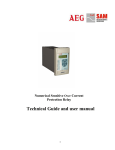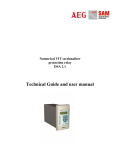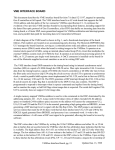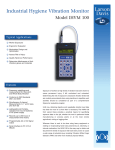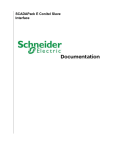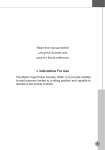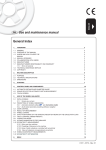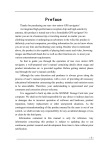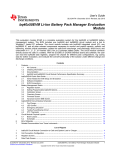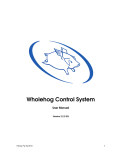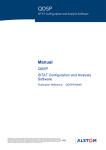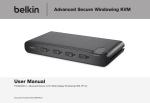Download Technical Guide and user manual
Transcript
Numerical overcurrent time and over load protection DOA 2.1 Technical Guide and user manual 1 Technical Guide and user manual Contents DOA 2.1 NUMERICAL OVERCURRENT RELAYS CONTENTS Introduction Handling, Installation and Case Dimensions User Guide Menu Content Tables Technical Data and Curve Characteristics Application Guide 2 Introduction Page 1/5 DOA 2.1 CONTENTS 1. INTRODUCTION 2 2. HOW TO USE THIS MANUAL 3 3. INTRODUCTION TO THE DOA 2.1 4 4. MAIN FUNCTIONS 5 3 Introduction Page 2/5 DOA 2.1 1. INTRODUCTION The overcurrent relay type DOA 2.1 is a numerical relay have been designed to control, protect and monitor industrial installations, public distribution networks and substations, and to be used as back-up protection for EHV and HV transmission networks. 4 Introduction Page 3/5 DOA 2.1 2. HOW TO USE THIS MANUAL This manual provides a description of DOA 2.1 functions and settings. The goal of this manual is to allow the user to become familiar with the application, installation, setting and commissioning of these relays. This manual has the following format : DOA 2.1 Introduction Contents of the manual and general introduction to the relay DOA 2.1 Handling, installation and case dimensions Precautions to be taken when handling electronic equipment. DOA 2.1 User Guide of the relay as A detailed description of the features DOA 2.1 Technical data and curve characteristics Comprehensive details on nominal values, setting ranges, specifications and curves characteristics. DOA 2.1 Commissioning and Maintenance Guide Guide to commissioning, problem solving and maintenance of DOA 2.1 DOA 2.1 Connection diagrams for the relay DOA 2.1 Commissioning test records DOA 2.1 Hardware/Software version history DOA 2.1 Communication mapping data bases 5 Introduction Page 4/5 DOA 2.1 3. INTRODUCTION TO THE DOA 2.1 RELAY The DOA 2.1 relay provide comprehensive overcurrent phase and earth fault protection for utilities networks, industrial plants and networks as well as for other applications where overcurrent protection is required. The earth fault protection is sensitive enough to be applied in electrical networks where the earth fault current is low. In addition to its protective functions, each relay offers control and recording features. They can be fully integrated to a control system so protection, control, data acquisition and recording of faults, events and disturbances can be made available. The relay is equipped on the front panel with a liquid crystal display (LCD) with 2 x 16 back-lit alphanumerical characters, a tactile 7 button keypad (to access all settings, clear alarms and read measurements) and 11 LEDs that indicate the status of the relay. In addition, the use of the RS485 communication port makes it possible to read, reinitialize and change the settings of the relay, if required, from a local or remote PC computer loaded with software. Its flexibility of use, reduced maintenance requirements and ease of integration allow the Relay to provide an adaptable solution for the problems of the protection electric networks. 6 Introduction Page 5/5 DOA 2.1 4. MAIN FUNCTIONS The following table shows the functions available for DOA 2.1 relay. Functions Three-phase overcurrent ANSI Code DOA 2.1 50/51 yes Earth fault overcurrent 50N/51N Restricted Earth fault 64N yes yes yes Instantaneous/start contact Latching output contacts 86 Setting groups yes 2 yes Blocking logic yes Measurements (True RMS) yes RS 232 front communication yes Fault Record , Event Record yes RS 485 rear communication (Modbus RTU, IEC 60870-5-103, Courier, DNP3.0) 7 Handling, Installation and Case Dimensions DOA 2.1 HANDLING, INSTALLATION AND CASE DIMENSIONS 8 Handling, Installation and Case Dimensions Page 1/8 DOA 2.1 CONTENTS 1. GENERAL CONSIDERATIONS 2 1.1 Receipt of relays 2 1.2 Electrostatic discharge (ESD) 2 2. HANDLING OF ELECTRONIC EQUIPMENT 3 3. RELAY MOUNTING 4 4. UNPACKING 5 5. STORAGE 6 6. DIMENSIONS 7 7. Communication 8 7.1 RS232 Port 8 7.2 RS485 port 8 8. Earthing 8 9 Handling, Installation and Case Dimensions Page 2/8 DOA 2.1 1. GENERAL CONSIDERATIONS 1.1 Receipt of relay Protective relay, although generally of robust construction, require careful treatment prior to installation on site. Upon receipt, relay should be examined immediately to ensure no damage has been sustained in transit. If damage has been sustained during transit a claim should be made to the transport contractor and AEG SAM should be promptly notified. 1.2 Electrostatic discharge (ESD) The relay use components that is sensitive to electrostatic discharges. The electronic circuits are well protected by the metal case and the internal module should not be withdrawn unnecessarily. When handling the module outside its case, care should be taken to avoid contact with components and electrical connections. If removed from the case for storage, the module should be placed in an electrically conducting antistatic bag. There are no setting adjustments within the module and it is advised that it is not unnecessarily disassembled. Although the printed circuit boards are plugged together, the connectors are a manufacturing aid and not intended for frequent dismantling; in fact considerable effort may be required to separate them. Touching the printed circuit board should be avoided, since complementary metal oxide semiconductors (CMOS) are used, which can be damaged by static electricity discharged from the body. 10 Handling, Installation and Case Dimensions Page 3/8 DOA 2.1 2. HANDLING OF ELECTRONIC EQUIPMENT A person’s normal movements can easily generate electrostatic potentials of several thousand volts. Discharge of these voltages into semiconductor devices when handling electronic circuits can cause serious damage, which often may not be immediately apparent but the reliability of the circuit will have been reduced. The electronic circuits are completely safe from electrostatic discharge when housed in the case. Do not expose them to risk of damage by withdrawing modules unnecessarily. Each module incorporates the highest practicable protection for its semiconductor devices. However, if it becomes necessary to withdraw a module, the following precautions should be taken to preserve the high reliability and long life for which the equipment has been designed and manufactured. 1. Before removing a module, ensure that you are at the same electrostatic potential as the equipment by touching the case. 2. Handle the module by its front plate, frame or edges of the printed circuit board. Avoid touching the electronic components, printed circuit track or connectors. 3. Do not pass the module to another person without first ensuring you are both at the same electrostatic potential. Shaking hands achieves equal potential. 4. Place the module on an antistatic surface, or on a conducting surface which is at the same potential as yourself. 5. Store or transport the module in a conductive bag. If you are making measurements on the internal electronic circuitry of an equipment in service, it is preferable that you are earthed to the case with a conductive wrist strap. Wrist straps should have a resistance to ground between 500kΩ – 10MΩ. If a wrist strap is not available you should maintain regular contact with the case to prevent a build-up of static. Instrumentation which may be used for making measurements should be earthed to the case whenever possible. More information on safe working procedures for all electronic equipment can be found in BS5783 and IEC147. It is strongly recommended that detailed investigations on electronic circuitry or modification work should be carried out in a special handling area such as described in the above-mentioned BS and IEC documents. 11 Page 4/8 Handling, Installation and Case Dimensions DOA 2.1 3. RELAY MOUNTING The relay is dispatched either individually or as part of a panel/rack assembly. If a test block is to be included it should be positioned at the right-hand side of the assembly (viewed from the front). Modules should remain protected by their metal case during assembly into a panel or rack. For individually mounted relays an outline diagram is supplied in following of this chapter showing the panel cut-outs and hole centres. 12 Page 5/8 Handling, Installation and Case Dimensions DOA 2.1 4. UNPACKING Care must be taken when unpacking and installing the relay so that none of the parts is damaged or the settings altered. The relay must only be handled by skilled personnel. The installation should be clean, dry and reasonably free from dust and excessive vibration. The site should be well lit to facilitate inspection. The relay that have been removed from the case should not be left in a situation where that is exposed to dust or damp. This particularly applies to installation which is being carried out at the same time as construction work. 13 Page 6/8 Handling, Installation and Case Dimensions DOA 2.1 5. STORAGE If relay is not to be installed immediately upon receipt they should be stored in a place free from dust and moisture in their original cartons. Where de-humidifier bags have been included in the packing they should be retained. The action of the de-humidifier crystals will be impaired if the bag has been exposed to ambient conditions and may be restored by gently heating the bag for about an hour, prior to replacing it in the carton. Dust which collects on a carton may, on subsequent unpacking, find its way into the relay; in damp conditions the carton and packing may become impregnated with moisture and the de-humidifier will lose its efficiency. Storage temperature : –25°C to +70°C. 14 Page 7/8 Handling, Installation and Case Dimensions DOA 2.1 6. CASE DIMENSIONS The relay is available in a 4U metal case for panel or flush mounting. Weight : 1.8 Kg front panel 177 mm front panel 103 mm front panel + case 252 mm External size : Height case 152 mm Width case 97 mm Depth case 226 mm 102.4 15 Page 8/8 Handling, Installation and Case Dimensions DOA 2.1 7. Communication 7.1 RS232 Port In the bottom of the front panel, there is a RS232 port, The communication with a computer through the RS232 allows access to the relay all information and setting. It makes the access and changes of any information, setting and configuration . You can see all events and records by this port on monitor of computer we will explain it by details in the next sections. 7.2 RS485 port Connections to RS485 is made using annular terminals. It is recommended that a two core screened cable, is used with a maximum total length of 1000 m or a200nF total cable capacitance. Typical specification: − Each core : 16/0.2 mm copper conductor, PVC insulated. − Nominal conductor area : 0.5 mm² per core − Screen : Overall braid, PVC sheathed − Linear capacitance between conductor and earth : 100pF/m 8. Earthing Each equipment must be connected to a local earth terminal by the intermediary of a M4 earth terminals. We recommend a wire of minimal section of 2,5 mm², with annular terminals on the side of the equipment. Because of the limitations of the annular terminals, the possible maximum section is of 6mm² by wire. If a larger section is necessary, one can use cables connected in parallel, each one ending with an annular terminal separated on the side of the equipment. One can also use a metal bar. NOTE: To prevent any electrolytic risk between copper conductor or brass conductor and the back plate of the equipment, it is necessary to take precautions to isolate them one from the other. This can be done in several ways, for example by inserting between the conductor and the case a plated nickel or insulated ring washer or by using a tin terminals. 16 User Guide DOA 2.1 User Guide 17 User Guide Page 1/13 DOA 2.1 CONTENTS 1. PRESENTATION OF DOA 2.1 RELAY 2 2. USER INTERFACE 3 2.1 LCD display and keypad description 4 2.1.1 LCD display 4 2.1.2 Keypad 4 2.2 LEDs 5 2.3 Description of the two areas under the top and bottom flaps 6 3. PASSWORD 7 3.1 Password protection 7 3.1.1 Password entry 7 3.1.2 Changing the password 7 3.1.3 Change of setting invalidation 8 4. DISPLAYS OF ALARM & WARNING MESSAGES 8 4.1 Electrical Network Alarms 8 4.2 Relay Hardware or Software Warning Messages 10 5. MENUS 12 5.1 Default display 12 5.2 Access to the menu 12 5.3 Menu contents description 12 18 User Guide Page 2/13 DOA 2.1 1. PRESENTATION OF DOA 2.1 RELAY This relay is fully numerical relays designed to perform electrical protection and control functions. DOA 2.1 relay is a self power relay also could powered either from a DC or an AC auxiliary power supply. Using the front panel, the user can easily navigate through the menu and access data, change settings, read measurements, etc. Eleven LEDs situated in the front panel help the user to quickly know the status of the relay and the presence of alarms. Alarms that have been detected are stored and can be displayed on the back-lit LCD. Any short time voltage interruption (<50ms) is filtered and regulated through the auxiliary power supply. DOA 2.1 relay have 3 phase and 1 earth current inputs available for 1 and 5 Amps rated CTs. On each one of these relay, it is possible to combine 1 and 5 Amp current inputs together (a mix between 1A for earth fault and 5A for phase connections). DOA 2.1 relay continuously measure phase and earth currents and take into account the true RMS current value up to 10th harmonic (at 50 Hz). Output relays are freely configurable and can be activated by any of the control or protection functions available in the relay. Logic inputs can also be assigned to various control functions. On their rear terminals DOA 2.1 have a standard RS485 port available. When ordering, the user can choose between the following communication protocol: ModBus RTU, IEC 60870-5-103, Courier or DNP3.0. Using RS485 communication channel, all stored information (measurements, alarms, and parameters) can be read and settings can be modified when the chosen protocol allows it. DOA 2.1 relay can be connected directly to a digital control system. All the available data can then be gathered by a substation control system and be processed either locally or remotely. 19 User Guide Page 3/13 DOA 2.1 2. USER INTERFACE DOA 2.1 relay from panel allows the user to easily enter relay settings, display measured values and alarm and to clearly display the status of the relay. 2 × 16 alphanumerical backlit display 2 buttons to read and clear alarms messages Trip led Alarm led Warning led Programmable leds 5 buttons to modify the setting and read vaues Battrey RS 232 FIGURE 1 : DOA 2.1 front panel The front panel of the relay has three separate sections: 1. The LCD display and the keypad, 2. The LEDs 3. The two zones under the upper and lower flaps. 20 User Guide Page 4/13 DOA 2.1 2.1 LCD display and keypad description 2.1.1 LCD display In the front panel, a liquid crystal display (LCD) displays settings, measured values and alarms. Data is accessed through a menu structure. The LCD has two lines, with sixteen characters each. A back-light is activated when a key is pressed and will remain lit for five minutes after the last key press. This allows the user to be able to read the display in most lighting conditions. 2.1.2 Keypad The keypad has seven keys divided into two groups : Two keys located just under the screen (keys © and ® ). keys © and ® are used to read and acknowledge alarms. To display successive alarms, press key ® . Alarms are displayed in reverse order of their detection (the most recent alarm first, the oldest alarm last). To acknowledge the alarms, the user can either acknowledge each alarm using © or go to the end of the ALARM menu and acknowledge all the alarms at the same time. When navigating through submenus, key © is also used to come back to the head line of the corresponding menu. NOTE : To acknowledge a relay latched refer to the corresponding submenu section. Four main arrow keys located in the middle of the front panel. They are used to navigate through the different menus and submenus and to do the setting of the relay. The enter key is used to validate a choice or a value (modification of settings). 21 User Guide Page 5/13 DOA 2.1 2.2 LEDs The top three LEDs indicate the status of the relay (Trip condition, alarm LED, equipment failure). The five lower LEDs are freely programmable by the user and can be assigned to display a threshold crossing for example (available for all models) or to show the status of the logic inputs .The description of each one of these eight LEDs located in the left side of the front view is given hereafter(numbered from the top to bottom from 1 to 3) , 3 LEDs at bottom showed by G1 , G2 , auxiliary supply. LED 1 Colour : RED Label : Trip LED 1 indicates that the relay has issued a trip order to the cut-off element (circuit breaker, contactor). This LED recopies the trip order issued to the Trip logic output. As soon as a triggering order is issued, the LED lights up. It is cleared when the associated alarm is acknowledged either through the front panel, or by a remote command, a digital input, or by a new fault (configuration/Alarms menu). LED 2 Colour : yellow Label : ALARM LED 2 indicates that the relay has detected an alarm. This alarm can either be a threshold crossing (instantaneous), or a trip order (time delayed). As soon as an alarm is detected, the LED starts blinking. After all the alarms have been read, the LED lights up continuously. After acknowledgement of all the alarms, the LED is extinguished. The alarm LED can be reset either through the front panel, or by remote command, by a digital input, or by a new fault. LED 3 Colour : YELLOW Label : Warning LED 3 indicates internal alarms of the relay. When the relay detects a « non critical » internal alarm (typically a communication failure), the LED starts blinking continuously. When the relay detects a fault that is considered as « critical », the LED lights up continuously. Only the disappearance of the cause of the fault can clear this LED (repair of the module, clearance of the Fault). LED G1 : this LED indicates that group1 adjustment is active LED G2 : this LED indicates that group2 adjustment is active LED power : this LED indicates that power is alive on. 22 User Guide Page 6/13 DOA 2.1 2.3 Description of the two areas under the top and bottom flaps There is RS232 port available in the relay. This RS232 port can be used either to download a new version of the application software version into the relay flash memory or to plug a laptop loaded with setting software. To withdraw more easily the active part of the relay (i-e the chassis) from its case, open the two flaps, then with a 3mm screwdriver, turn the extractor located under the upper flap, and pull it out of its case pulling the flaps towards you. 23 User Guide Page 7/13 DOA 2.1 3. PASSWORD 3.1 Password protection An unlock key (up+down) is required , when you want to press any key . after 5 minutes that you don’t press any key , you must unlock the keys for navigation through menus. A password is required for relay settings, especially when changing the various thresholds, time delays, communication parameters, allocation of inputs and outputs relays. The password consists of four capital characters. When leaving factory, the password is set to AAAA. The user can define his own combination of four characters. Should the password be lost or forgotten, the modification of the stored parameters is blocked. It is then necessary to contact the manufacturer or his representative and a standby password specific to the relay may be obtained. The programming mode is indicated with the letter "P" on the right hand side of the display on each menu heading. The letter "P" remains present as long as the password is active (5 minutes if there is no action on the keypad). 3.1.1 Password entry The input of the password is requested as soon as a modification of a parameter is made for any one of the six/eight menus and the submenus. The user enters each one of the 4 characters and then validates the entire password with enter keypad. After 5 seconds, the display returns to the point of the preceding menu. If no key is pressed inside of 5 minutes, the password is deactivated. A new password request is associated with any subsequent parameter modification. 3.1.2 Changing the password To change an active password, go to the OP. PARAMETERS menu and then to the Password submenu. Enter the current password and validate it. Then press enter keypad and enter the new password character by character and validate the new password using enter keypad. The message NEW PASSWORD OK is displayed to indicate that the new password has been accepted. 24 User Guide Page 8/13 DOA 2.1 3.1.3 Change of setting invalidation The procedure to modify a setting is described in the following sections of this manual. If there is a need to get back to the old setting push key © before validating the setting change. The following message will then appear on the LCD for a few seconds and the old setting will remain unchanged. UPGRADE CANCEL 4. DISPLAYS OF ALARM & WARNING MESSAGES Alarm messages are displayed directly on the front panel LCD. They have priority over the default display presenting measured current values. As soon as the relay detects an alarm condition (crossing of a threshold for example), the associated message is displayed on the front panel LCD and the LED Alarm (LED 2) lights up. We distinguish two types of alarm and warning messages : - Alarm messages generated by the electrical power network. - Warning messages caused by hardware or software faults from the relay. 4.1 Electrical Network Alarms Any crossing of a threshold (instantaneous or time delay) generates an "electrical network alarm". The involved threshold is indicated. Regarding the phase thresholds, the phase designation (A, B or C) is also displayed. If several alarms are triggered, they are all stored in their order of appearance and presented on the LCD in reverse order of their detection (the most recent alarm first, the oldest alarm last). Each alarm message is numbered and the total number of alarm messages is displayed. The user can read all the alarm messages pressing ®. The user acknowledges and clears the alarm messages from the LCD pressing ©. The user can acknowledge each alarm message one by one or all by going to the end of the list to acknowledge, and clear, all the alarm messages pressing ©. The control of the ALARM LED (LED 2) is directly assigned to the status of the alarm messages stored in the memory. If one or several messages are NOT READ and NOT ACKNOWLEDGED, the ALARM LED (LED 2) flashes. If all the messages have been READ but NOT ACKNOWLEDGED, the ALARM LED (LED 2) lights up continuously. If all the messages have been ACKNOWLEDGED, and cleared, if the cause that generated the alarm disappears, the ALARM LED (LED 2) is extinguished. 25 User Guide Page 9/13 DOA 2.1 The different electrical system alarms are listed below: Ie> Ie>> Ie>>> I> I>> I>>> tIe> tIe>> tIe>>> tI> tI>> tI>>> LATCH RELAY LATCH RELAY TRIP 1st stage earth fault threshold 2nd stage earth fault threshold 3rd stage earth fault threshold 1st stage PHASE overcurrent threshold 2nd stage PHASE overcurrent threshold 3rd stage PHASE overcurrent threshold 1st stage earth fault time-out 2nd stage earth fault time-out 3rd stage earth fault time-out 1st stage PHASE overcurrent time-out 2nd stage PHASE overcurrent time-out 3rd stage PHASE overcurrent time-out At least one output relay is latched. The relay trip is latched. 26 User Guide Page 10/13 DOA 2.1 4.2 Relay Hardware or Software Warning Messages Any software or hardware fault internal to DOA2.1 relay generates a "hardware/software alarm" that is stored in memory as a "Hardware Alarm". If several hardware alarms are detected they are all stored in their order of appearance. The warning messages are resented on the LCD in reverse order of their detection (the most recent first and the oldest last). Each warning message is numbered and the total stored is shown. The user can read all warning messages pressing ®, without entering the password. It is not possible to acknowledge and clear warning messages caused by internal relay hardware or software failure. This message can only be cleared once the cause of the hardware or software failure has been removed. The control of the WARNING LED (LED 3) is directly assigned to the status of the warning messages stored in the memory. If the internal hardware or software failure is major (i.e. the relay cannot perform protection functions), the WARNING LED (LED 3) lights up continuously. If the internal hardware or software failure is minor (like a communication failure that has no influence on the protection and automation functions), the WARNING LED (LED 3) will flash. Possible Hardware or Software alarm messages are: Major fault: The protection and automation functions are stopped. The RL0 watchdog relay is de-energised (35-36 contact closed). <<EEPROM ERROR CALIBR.>> : Calibration zone failure <<CT ERROR>> : Analog channel failure Minor fault: The DOA 2.1 relay is fully operational. The RL0 watchdog relay is energised (35-36 contact open, 36-37 contact closed). <<RAM ERROR>> : RAM supplied by battery failed. <<Battery fail>> : battery failure (flat or not correctly in place) 27 User Guide Page 11/13 DOA 2.1 NOTE : The <<Battery backed RAM memory>> and <<Battery failure>> alarm messages can be configured to be displayed or not by selecting yes or no, in the configuration/Alarms menu. << DEFAULT SETTINGS (*) >> << SETTING ERROR (**) >> <<COMM.ERROR>> : Communication failure <<CLOCK ERROR>> : Time tag failure (*) DEFAULT SETTINGS: Each time the relay is powered ON it will check its memory contents to determine whether the settings are set to the factory defaults. If the relay detects that the default settings are loaded an alarm is raised. The ALARM LED (YELLOW) will light up and the Watch Dog contact will be activated. Only one parameter in the relay's menu needs to be changed to suppress these messages and to reset the watch dog. This alarm is only an indication to the user that the relay has its default settings applied. (**) SETTING ERROR: Should the CPU fails to get correctly store data to the EEPROM during a setting change, a "HARDWARE" ALARM will appear on the LCD display followed by "SETTING ERROR" message (when pushing on the button). In addition, the ALARM LED (YELLOW) will light up and the Watch Dog contact will be activated To reset this alarm it is necessary to power ON and OFF the relay. Following this, the last unsuccessful setting change will then need to be re-applied. If the alarm persists, i.e. the "SETTING ERROR" alarm is still displayed, please contact AEG sam After Sales Services for advice and assistance. 28 User Guide Page 12/13 DOA 2.1 5. MENUS The menu of DOA 2.1 relay is divided into main menus and submenus. The available content depends on the model of the relay. 5.1 Default display By default, the LCD displays the current value measured (selected phase or earth). As soon as an alarm is detected by the relay, that information is considered as more important and the alarm message is then displayed instead of the default value. The user can configure the information he wants to display by default going under the CONFIGURATION/Display menu. 5.2 Access to the menu Navigation through the different menus is done pressing the arrow keys . The organisation of the menus is shown in figure as follows . There is need of an unlock key when reading parameters and measured values. Modification of a parameter requires entering a password. Should an error be made in entering a parameter, press © to cancel. NOTE : The letter P is displayed when the password needs to be entered. If no key is pushed during 5 minutes, the password needs to be entered again. 5.3 Menu contents description The menu of DOA 2.1 relay is divided into 8 main sections OP PARAMETERS CONFIGURATION MEASUREMENTS COMMUNICATION PROTECTION G(1) PROTECTION G2 AUTOMAT. CTRL RECORDS To access these menus from the default display press 29 . User Guide Page 13/13 DOA 2.1 30 Menu Content Tables DOA 2.1 MENU CONTENT TABLES And description of details are as follow 31 Menu Content Tables Page 1/9 DOA 2.1 32 Menu Content Tables Page 2/9 DOA 2.1 33 Menu Content Tables Page 3/9 DOA 2.1 34 Menu Content Tables Page 4/9 DOA 2.1 35 Menu Content Tables Page 5/9 DOA 2.1 36 Menu Content Tables Page 6/9 DOA 2.1 37 Menu Content Tables Page 7/9 DOA 2.1 38 Menu Content Tables Page 8/9 DOA 2.1 39 Menu Content Tables Page 9/9 DOA 2.1 40 Technical Data DOA 2.1 TECHNICAL DATA AND CHARACTERISTIC CURVES 41 Technical Data Page 1/25 DOA 2.1 CONTENT 1. RATINGS 2 1.1 Power Supply 2 1.2 Frequency 2 1.3 Current Inputs 2 1.4 Logic Inputs 3 1.4.1 Supply 3 1.5 Output Relay Characteristic 3 2. INSULATION 4 3. EMC TESTS 4 4. ENVIRONMENT 5 5. Deviation of Protection Elements 6 6. PROTECTION SETTING RANGES 7 6.1 [50/51] Phase Overcurrent 7 6.1.1 Protection Setting Ranges 7 7. RECORDING FUNCTIONS 8 7.1 Event Records 8 7.2 Fault Records 9 7.3 Instantaneous recorder 9 8. COMMUNICATION 9 42 Technical Data DOA 2.1 9. CURVES 10 9.1 General 10 9.1.1 Inverse Time Curves 10 9.1.2 Reset Timer 11 9.2 IEC Curves 13 9.3 RI Curves 19 9.4 IEEE/ANS & Curves 20 43 Technical Data Page 2/25 DOA 2.1 1. RATINGS 1.1 Power Supply Nominal auxiliary voltage Vx Operating range Residual ripple Stored energy time Burden 48-200VDC; 130-250VDC/100-250VAC AC,DC ± 20% of Vx Up to 12% ≥50 ms for interruption of Vx Stand by : <2W DC or <4VA AC Max : <5W DC or <10VA AC 1.2 Frequency Frequency protection functions Nominal frequency From 45 to 65Hz 50/60Hz 1.3 Current Inputs Phase current inputs Earth current inputs Operating range Burden Phase Current Burden Earth Current Thermal withstand 1 and 5A by connection 1 and 5A by connection Selection by ordering code < 0.025 VA (1A) < 0.3 VA (5A) < 0.008 VA (1A) < 0.010 VA (5A) 1s @ 100 x rated current 2s @ 40 x rated current continuous @ 4 x rated current 44 Technical Data Page 3/25 DOA 2.1 1.4 Logic Inputs Logic input type Logic input burden Logic input recognition time Independent optically insulated < 10 m Amps per input < 10ms 1.4.1 Supply The logic inputs shall be powered with a DC or AC voltage. 48 – 200 Vdc or 35 – 150 Vac 1.5 Output Relay Characteristic Contact rating Contact relay Make current Carry capacity Rated Voltage Breaking characteristic Breaking capacity AC Breaking capacity DC Operation time Durability Loaded contact Unloaded contact Dry contact Ag CdO Max. 30A and carry for 3s 5A continuous 250Vac 1250 VA resistive 1250 VA inductive (P.F. = 0.5) 220 Vac, 5A (cos ϕ = 0.6) 135 Vdc, 0.3A (L/R = 30 ms) 250 Vdc, 50W resistive or 25W inductive (L/R=40ms) <7ms 10000 operation minimum 100000 operation minimum 45 Technical Data Page 4/25 DOA 2.1 2. INSULATION Dielectric withstand IEC 60-255-5 2 kV common mode 1 kV differential mode Impulse voltage IEC 60-255-5 5 kV common mode 1 kV differential mode Insulation resistance IEC 60-255-5 > 1000 MΩ High frequency disturbance IEC 61000-4-1 2.5 kV common mode, Class 3 1 kV differential mode, Class 3 Fast transient IEC 61000-4-4 ANSI C37.90.1 4 kV common mode, class 4 2 kV others, class 4 Electrostatic Discharge IEC 61000-4-2 8 kV, class 4 RFI immunity radiated ANSI C37.90.2 IEC 61000-4-3 35 V/m 10 V/m 3. EMC TESTS 46 Technical Data Page 5/25 DOA 2.1 4. ENVIRONMENT Temperature IEC 600-68-2-1 IEC 600-68-2-2 Storage –25 °C to + 70 °C Operation -25 °C to +55 °C Humidity dam heat IEC 600-68-2-3 56 days at 93% RH and 40 °C Enclosure protection IEC 60-529 IP 52, IK 07 Sinusoidal Vibrations IEC 60-255-21-1 Response and endurance, class 2 Shocks IEC 60-255-21-2 Response and withstand, class 1 Bump IEC 60-255-21-2 Response and withstand, class 1 Seismic IEC 60-255-21-3 Class 1 47 Technical Data Page 6/25 DOA 2.1 5. Deviation of Protection Elements Glossary I Is Ies : phase : I > , I >> , I>>> : Ie > , Ie >> , Ie>>> Element Range Deviation Trigger Reset Phase overcurrent Elements I > , I >> , I>>> Earth fault overcurrent Elements Ie > , Ie >> , Ie>>> 0.1 to 40 In ± 2% DT : Is± 2% IDMT : 1.1 Is ± 2% 0.95 Is ± 2% ± 2% +30 … 50 ms 1.05 Is ± 2% ± 5% +30 … 50 ms 0.1 to 40 In ± 2% DT : Ies± 2% IDMT: 1.1 Ies ± 2% 0.95 Is ± 2% ± 2% +30 … 50 ms 1.05 Is ± 2% ± 5% +30 … 50 ms 48 Time deviation Technical Data Page 7/25 DOA 2.1 6. PROTECTION SETTING RANGES 6.1 [50/51] Phase and Earth Overcurrent DOA 2.1 6.1.1 Protection Setting Ranges Setting Range Max Step 25 In 0.01 In [50/51] Phase OC I> Min 0.1 In Delay type DT or IDMT (IEC_STI, IEC_SI, IEC_VI, IEC_EI, IEC_LTI, C02, C08, IEEE_MI, IIEEE_VI, IEEE_EI, RI, RECT curve) 0s 300 s 0.01 s 0.025 1.5 0.025 DT or IDMT 0.025 3.2 0.025 40 ms 100 s 0.01 s 0.5 In 40 In 0.01 In DT or IDMT (IEC_STI, IEC_SI, IEC_VI, IEC_EI, IEC_LTI, C02, C08, IEEE_MI, IIEEE_VI, IEEE_EI, RI, RECT curve) 0s 300 s 0.01 s 0.025 1.5 0.025 0.5 In 40 In 0.01 In 0s 300 s 0.01 s tI> I> TMS I> Reset Delay Type I> RTMS I> tReset I>> Delay type tI>> I>> TMS I>>> tI>>> The dynamic range of measurement is typically 400 time of the minimum setting . 49 Technical Data Page 8/25 DOA 2.1 Setting Range Max Step 25 In 0.01 In [50N/51N] Earth OC Ie> Min 0.1 In Delay type DT or IDMT (IEC_STI, IEC_SI, IEC_VI, IEC_EI, IEC_LTI, C02, C08, IEEE_MI, IIEEE_VI, IEEE_EI, RI, RECT curve) 0s 300 s 0.01 s 0.025 1.5 0.025 DT or IDMT 0.025 3.2 0.025 40 ms 100 s 0.01 s 0.5 In 40 In 0.01 In DT or IDMT (IEC_STI, IEC_SI, IEC_VI, IEC_EI, IEC_LTI, C02, C08, IEEE_MI, IIEEE_VI, IEEE_EI, RI, RECT curve) 0s 300 s 0.01 s 0.025 1.5 0.025 0.5 In 40 In 0.01 In 0s 300 s 0.01 s tIe> Ie> TMS Ie> Reset Delay Type Ie> RTMS Ie> tReset Ie>> Delay type tIe>> Ie>> TMS Ie>>> tIe>>> 7. RECORDING FUNCTIONS 7.1 Event Records Capacity Time-tag Triggers 75 events 1 millisecond Any selected protection alarm and Threshold logic input change of state Setting changes Self test events 50 Technical Data Page 9/25 DOA 2.1 7.2 Fault Records Capacity Time-tag Triggers 5 faults 1 millisecond Any selected protection alarm and threshold Fault date Protection thresholds Setting Group AC inputs measurements (RMS) Fault measurements Data 7.3 Instantaneous recorder Capacity Time-tag Triggers 5 starting information’s instantaneous 1 millisecond Any selected protection alarm and threshold date, hour origin (any protection alarm) length (duration of the instantaneous trip yes or no Data 8. COMMUNICATION Type Port Physical Link Screened twister Pair Connectors Data Rate Protocol RS485 Relay Position Rear port Screws or snap-on 300 to 38400 band (programmable) RS232 Rear port Screened twister Pair Sub–D 9 pin female connector 300 to 38400 band (programmable) ModBus RTU, Courier, IEC60870-5-103, DNP3.0 ModBus RTU 51 Technical Data Page 10/25 DOA 2.1 9. CURVES 9.1 General Although the curves tend towards infinite when the current approaches Is (general threshold), the minimum guaranteed value of the operating current for all the curves with the inverse time characteristic is 1.1Is (with a tolerance of ± 0.05Is). 9.1.1 Inverse Time Curves: The first and second stage thresholds for phase (earth) overcurrent can be selected with an inverse definite minimum time (IDMT) characteristic. The time delay is calculated with a mathematical formula. In all, there are eleven IDMT characteristics available. The mathematical formula applicable to the first ten curves is: ⎤ ⎡ ⎥ ⎢ K t =T ×⎢ + L⎥ ⎥ ⎢( I )a −1 ⎥ ⎢ I ⎦ ⎣ s Where: t K I Is α L T Operation time Factor (see table) Value of measured current Value of the programmed threshold (pick-up value) Factor (see table) ANSI/IEEE constant (zero for IEC and RECT curves) Time multiplier setting from 0.025 to 1.5 Type of curve Short time inverse Standard inverse Very inverse Extremely inverse Long time inverse Short time inverse Standard IEC IEC IEC IEC IEC C02 K factor 0.05 0.14 13.5 80 120 0.02394 52 α factor 0.04 0.02 1 2 1 0.02 L factor 0 0 0 0 0 0.01694 Technical Data Page 11/25 DOA 2.1 Type of curve Moderately Inverse Long time inverse Very inverse Extremely inverse Rectifier protection Standard ANSI/IEEE C08 ANSI/IEEE ANSI/IEEE RECT K factor 0.0515 5.95 19.61 28.2 45900 α factor 0.02 2 2 2 5.6 L factor 0.114 0.18 0.491 0.1217 0 The RI curve has the following definition: t = K. 1 ⎛I ⎞ 0.339 − ⎜⎜ ⎟⎟ ⎝ Is ⎠ 0.236 K setting is from 0.10 to 10 in steps of 0.05. The equation is valid for 1.1 ≤ I/Is ≤ 20. 9.1.2 Reset Timer The first stage thresholds for phase and earth overcurrent protection are provided with a timer hold facility "t Reset". It may be set to a definite time value or to an inverse definite minimum time characteristic (IEEE/ANSI curves only). This may be useful in certain applications, for example when grading with upstream electromechanical overcurrent relays that have inherent reset time delays. A possible situation where the reset timer may be used is to reduce fault clearance times where intermittent faults occur. An example may occur in a cable with plastic insulation. In this application it is possible that the fault energy melts the cable insulation, which then reseals after clearance, thereby eliminating the cause for the fault. This process repeats itself 53 Technical Data Page 12/25 DOA 2.1 to give a succession of fault current pulses, each of increasing duration with reducing intervals between the pulses, until the fault becomes permanent. By using the reset timer hold function the relay will integrate the fault current pulses, thereby reducing fault clearance time. The mathematical formula applicable to the five curves is: ⎤ ⎡ ⎥ ⎢ K ⎥ t =T ×⎢ ⎢1 − ( I ) a ⎥ ⎢ I s ⎥⎦ ⎣ Where: t K I Is α T Reset time Factor (see table) Value of the measured current Value of the programmed threshold (pick-up value) Factor (see table) Reset time multiplier (RTMS) setting between 0.025 and 1.5. Type of curve Short time inverse Moderately inverse Long time inverse Very inverse Extremely Inverse Standard C02 ANSI/IEEE C08 ANSI/IEEE ANSI/IEEE K factor 2.261 4.850 5.950 21.600 29.100 54 α factor 2 2 2 2 2 Technical Data Page 13/25 DOA 2.1 The following curves are given for indication only. 9.2 IEC Curves 55 Technical Data Page 14/25 DOA 2.1 56 Technical Data Page 15/25 DOA 2.1 57 Technical Data Page 16/25 DOA 2.1 58 Technical Data Page 17/25 DOA 2.1 59 Technical Data Page 18/25 DOA 2.1 60 Technical Data Page 19/25 DOA 2.1 9.3 RI Curves 61 Technical Data Page 20/25 DOA 2.1 9.4 IEEE/ANSI & CO Curves 62 Technical Data Page 21/25 DOA 2.1 63 Technical Data Page 22/25 DOA 2.1 64 Technical Data Page 23/25 DOA 2.1 65 Technical Data Page 24/25 DOA 2.1 66 Technical Data Page 25/25 DOA 2.1 67 Aplication Guide DOA 2.1 APLICATION GUIDE 68 Aplication Guide Page 1/16 DOA 2.1 CONTENTS 1. INTRODUCTION 2 1.1 Protection of Underground and Overhead Lines 2 1.2 SAM DOA 2.1 Overcurrent Relay 3 2. EARTH AND PHASE CURRENT OVERCURRENT FUNCTIONS 6 2.1 Instantaneous function (50/50N) 8 2.2 DMT thresholds 8 2.3 IDMT thresholds 8 2.3.1 Inverse time curves 8 2.4 Reset timer 9 2.5 Time graded protection 10 3. TRANSFORMER INRUSH CURRENTS 10 4. BLOCKING LOGIC FUNCTION 10 5. SETTING GROUP SELECTION 12 6. Scheme of operation 14 7. Scheme of operation for general connection of relay 15 69 Aplication Guide Page 2/16 DOA 2.1 1. INTRODUCTION 1.1 Protection of Underground and Overhead Lines The secure and reliable transmission and distribution of power within a network is heavily dependent upon the integrity of underground cables and overhead lines, which link the various sections of the network together. Therefore the associated protection system must also provide both secure and reliable operation. The most common fault conditions, on underground cables and overhead lines, are short circuit faults. These faults may occur between the phase conductors but will most often involve one or more phase conductor becoming short-circuited to earth. Faults caused by short circuits require the fastest faulted conductor clearance times but at the same time allowing for suitable co-ordination with other downstream protection devices. Fault sensitivity is an issue common to all voltage levels. For transmission systems, tower footing resistance can be high. Also, high resistance faults might be prevalent where lines pass over sandy or rocky terrain. Fast, discriminative faulted conductor clearance is required for these fault conditions. The effect of fault resistance is more pronounced on lower voltage systems, resulting in potentially lower fault currents, which in turn increases the difficulty in the detection of high resistance faults. In addition, many distribution systems use earthing arrangements designed to limit the passage of earth fault current. Earthed methods as such as using resistance, Petersen coil or insulated systems make the detection of earth faults arduous. Special protection equipment is often used to overcome these problems. Nowadays, the supply continuity in the energy distribution is of paramount importance. For permanent faults it is essential that only the faulted section of the network is isolated. High-speed, discriminative fault clearance is therefore a fundamental requirement of any protection scheme on a distribution network. 70 Aplication Guide Page 3/16 DOA 2.1 Power transformers are installed at all system voltage levels and have their own specific requirements with regard to protection. In order to limit the damage incurred by a transformer under fault conditions, fast clearance of the windings with phase to phase and phase to earth faults is a primary requirement. On large networks, time co-ordination of the overcurrent and earth fault protection relays can often lead to problematic grading situations or, as is often the case, excessive fault clearance times. Such problems can be overcome by relays operating in blocked overcurrent schemes. 1.2 SAM DOA 2.1 Overcurrent Relay SAM DOA 2.1 relay is a designed for application to a wide range of power system plant equipment such as motors, generators, feeders, overhead lines and cables. This relay has been designed to provide higher functionality in terms of protections, measuring, automatic operation and order control. They can be applied to industrial and distribution network applications, as well as in high voltage and extremely high voltage protection applications. They can operate in networks with neutral earthed by impedance, by resonant system such as Petersen coil, in insulated system and in system with neutral earthed. The protection functions can be used associated with the blocking feature in order to optimize the performance of the protection schemes, thus reducing operating times. 71 Aplication Guide Page 4/16 DOA 2.1 The earth and phase protection functions include instantaneous and time delay information. The delay time for the first and second stage for phase and earth fault protections can be chosen to be in definite or inverse delay time (IEC, ANSI/IEEE, CO and RI). This wide choice of characteristics of triggering times makes it possible to easily integrate an existing protection scheme. 72 Aplication Guide Page 5/16 DOA 2.1 The protection and features of this overcurrent relay Functions Three-phase overcurrent ANSI Code DOA 2.1 50/51 yes Earth fault overcurrent 50N/51N Restricted Earth fault 64N yes yes yes Instantaneous/start contact Latching output contacts 86 Setting groups yes 2 yes Blocking logic yes Measurements (True RMS) yes RS 232 front communication yes Fault Record , Event Record yes RS 485 rear communication (Modbus RTU, IEC 60870-5-103, Courier, DNP3.0) 73 Aplication Guide Page 6/16 DOA 2.1 2. EARTH AND PHASE CURRENT OVERCURRENT FUNCTIONS SAM DOA 2.1 of relay provide definite and independent time delay overcurrent protection. Each phase current and earth current input has three thresholds. The first and second thresholds can be set as definite delay time or inverse delay time using the IEC, IEEE/ANSI, CO and RI curves. Their parameters are shown in the Technical Data chapter of this Technical Guide. The third threshold can be set as definite delay time only. In a similar way, the earth fault elements has three different thresholds, that besides can be set independently of the settings chosen for the phases. The instantaneous thresholds are represented by the symbol “I>” for the first threshold, “I>>” and “I>>>” for the second and third instantaneous thresholds (“Ie>”, “Ie>>” and “Ie>>>” for earth thresholds). The time delayed thresholds are represented by the symbol “tI>” for the first threshold, “tI>>” and “tI>>>” for the second and third time delay thresholds (“tIe>”, “tIe>>” and “tIe>>>” for the time delay earth fault thresholds). The protection elements trip when the following conditions are realized: − The phase current exceeds the set overcurrent threshold. − The time delay has elapsed. − The blocking logic (if used) is not activated. 74 Aplication Guide Page 7/16 DOA 2.1 The following diagrams show the functionality for each threshold. LOGIC OF PHASE THRESHOLDS I>, I>> AND I>>> With: Max I> = [IA>] OR [IB>] OR [IC>] Max I>> = [IA>>] OR [IB>>] OR [IC>>] Max I>>> = [IA>>>] OR [IB>>>] OR [IC>>>] The logic associated to the earth fault threshold is identical to the one described above. The different thresholds I> & tI>, I>> & tI>> and I>>> & tI>>> are respectively replaced by thresholds Ie> & tIe>, Ie>> & tIe>> and Ie>>> & te>>>. Thanks to the «Blocking Logic» function, it is possible to freeze the timer as long as the "Blk Log" signal is active. As soon as the blocking “Blk Log" signal disappears, if the overcurrent value is still over the set threshold, the time delay resumes its countdown considering the value prior to the activation of the blocking function as its new initial value. This allows a faster clearance of the fault after a reset of the “Blk Log" signal. 75 Aplication Guide Page 8/16 DOA 2.1 2.1 Instantaneous function (50/50N) As soon as a phase (or earth) threshold is running, the instantaneous output associated with this threshold is activated. This output indicates that the protection element has detected a phase (or earth) fault and that the time delay associated with the threshold has started. This time delay can be blocked via the logic input "Blk Log" associated with this threshold. If this blocking input is activated by an output contact of a downstream relay, the logic that will lead to the trip command is then blocked only if the relay that is the closest to the fault can see and therefore eliminate the fault. This principle is known as «Blocking logic» or «Blocking». It is described in more detail in this document. 2.2 DMT thresholds The three phase (earth) overcurrent thresholds can be selected with a time constant delay. The time to operate is equal to the time delay set, plus the time for the output contact to operate (typically about 20 to 30 ms ; 20ms for a current exceeding or equal to 2 times the threshold) and the time required to detect the overcurrent state (maximum 20ms at 50Hz). 2.3 IDMT thresholds 2.3.1 Inverse time curves The first and second phases (earth) overcurrent threshold can be selected with a dependent time characteristic. The time delay is calculated with a mathematical formula. There are eleven inverse time characteristics available. The mathematical formula applicable to the first ten curves is : ⎞ ⎛ ⎟ ⎜ ⎟ ⎜ K t = T ×⎜ + L⎟ α ⎟ ⎜⎛ 1 ⎞ ⎟ ⎜ ⎜⎜ ⎟⎟ − 1 ⎠ ⎝ ⎝ Is ⎠ 76 Aplication Guide Page 9/16 DOA 2.1 Where: t K I IS α L T = Tripping time = Coefficient (see table) = Value of measured current = Value of the programmed threshold (Pick-up value) = Coefficient (see table) = ANSI/IEEE coefficient (zero for IEC curves) = Time multiplier between 0.025 and 1.5 2.4 Reset timer The first phase overcurrent threshold [I>/tI>] ([Ie>/tIe>] for the earth) has a reset timer. The value that is set for this reset timer corresponds to the minimum time during which the current value needs to be lower than 95% of the phase (or earth) threshold before the corresponding phase (or earth) time delay is reset. NOTE : This rule doesn’t apply when the protection triggers. When the protection triggers, the time delay tI> (or tIe>) is immediately reset. The value of this reset timer depends on the type of timer associated with the first phase (Earth) threshold. 77 Aplication Guide Page 10/16 DOA 2.1 2.5 Time graded protection Inverse definite minimum time relays are time graded in such a way that the relay closer to the fault operates faster than the upstream relays. This is referred to as relay coordination because if the relay nearest to the fault does not operate, the next relay will trip in a slightly longer time. The time grading steps are typically 400- ms, the operation times becoming progressively longer with each stage. When difficulty is experienced in arranging the required time grading steps, the use of a blocked overcurrent scheme should be considered (described in a later section). 3. TRANSFORMER INRUSH CURRENTS Either I>>/Ie>> or I>>>/Ie>>> elements can be used as high-set instantaneous elements. The design is such that they do not respond to the DC transient component of the fault current. The principle of operation allows the current settings to be set down to 35% of the prospective peak inrush current that will be taken by a transformer when it is energized. As a first approximation, the peak inrush is given by the reciprocal of the per unit series reactance of the transformer. 4. BLOCKING LOGIC FUNCTION (BLOCKED OVERCURRENT PROTECTION) This type of protection can be applied to radial feeder circuits where there is little or no back feed. For parallel feeders, ring circuits or where there can be a back feed from generators, directional relays should be considered. The blocking logic function allows the upstream IDMT relay to be blocked by the start output of a downstream relay that has detected the presence of fault current above its threshold. Thus both upstream and downstream relays can have the same current and time settings, and the blocking feature will automatically provide grading. If the breaker fail protection is active, the blocking order on the upstream relay will be removed if the down-stream circuit breaker fails to trip. Thus for a fault downstream from relay C, the start output from relay C will prevent relay B from operating and the start output of relay B will prevent relay A from 78 Aplication Guide Page 11/16 DOA 2.1 operating. Thus all 3 relays could have the same time and current threshold settings and the grading would be obtained by the blocking signal received from a relay closer to the fault. This gives a constant, close time grading, but there will be no back-up protection in the event of pilots being short circuited. However, in practice it is recommended to set the upstream relay to a value that is 10% higher than the downstream relay setting. This ensures that the downstream relay successfully blocks the upstream relay when required. To assign the "Blocking Logic" functions, go under the AUTOMAT CTRL/Blocking Logic menu. 79 Aplication Guide Page 12/16 DOA 2.1 5. SETTING GROUP SELECTION DOA 2.1 relay has two setting groups associated to the protection functions named PROTECTION G1 and PROTECTION G2. Only one group is active. Switching between the groups can be done via: − the relay front panel interface (CONFIGURATION/GROUP SELECT/ ACTIVE GROUP 1 or 2), − a dedicated logic input (AUTOMAT. CTRL/INPUT X/CHANGE SET) where X is the chosen logic input, To avoid any false trip, the change of setting group is only carried out when no protection function is running. If a setting group change is received during any protection or automation function, it is stored and executed after the last timer has elapsed. The user can check which one of the active group is active looking under the OP PARAMETERS menu. The user can also assign the active group to an output relay. Using a normally open contact, this means that: − an open contact will indicate that the active group is Group 1 − a close contact will indicate that the active group is Group 2 Change of setting group done by a digital input It is possible to change the setting group via the activation of a digital input (on level).The user can select an activation of the input on low level or high level going under the CONFIGURATION/Group Select/Active Group. The active group is the group selected when in put is not activated and vise versa. Warning: if the digital input that has been assigned to the change of setting group, it is not possible to change the setting group via remote communication or front panel. 80 Aplication Guide Page 13/16 DOA 2.1 SWITCH BETWEEN ACTIVE GROUPS : When powering on the relay, the group selected (Group 1 or Group 2) corresponds to the state of the logic input. This means: A – Active group = 1 Group 1 = logic Input is not active Group 2 = logic Input is active If the programmable logic input is supplied with +V, then the active group will be G2. If the logic input is not supplied with +V , then the active group will be G1. B - Active group = 2 Group 1 = logic Input is active Group 2 = logic Input is not active If the programmable logic input is energized with +V, then the active group will be G1. If the programmable logic input is not energized with +V, then the active group will be G2. Priority When changing parameters through the front panel, the priority is given to the user that takes local control of the relay when entering a password. Change of setting group done via a remote command is not allowed for as long as the password is active (5minute). ORIGIN OF THE ORDER PRIORITY LEVEL FRONT PANEL MAXIMUM LOGIC INPUT MEDIUM REMOTE COMMUNICATIONS MINIMUM 81 Aplication Guide Page 14/16 DOA 2.1 6. Scheme of operation How to use the relay in Circuit For using of the relay we can connect it as blow . As you see we can choose one amp current or five amps current depend on the request . Fig 1 This schematic is for test of the relay by current injection . 82 Aplication Guide Page 15/16 DOA 2.1 7. Scheme of operation for General connection of relay We see here one of the most simple of the relay in connection with primary CT’s For using of this circuit by using SAM DOA 2.1 relay you con refer to figures of next page The number of the terminals are shown exactly as it is in the rear of the relay, for CT’s inputs, programmable digital inputs, relay outputs and communication RS 485 port . 83 The current inputs are connected to 3 phase CTs U U V W + AUxiliary voltage _ 33 34 5 41 V W 5A Phase rotation RL1 42 3 1 11 Tripping output 9 7 15 13 19 17 programmeable ALARM 43 5A RL2 44 Case earth RL3 45 5A 29 30 31 32 33 34 35 36 37 38 39 40 41 42 43 44 45 46 47 48 49 50 51 52 53 54 55 56 1 3 5 7 9 11 13 15 17 19 21 23 25 27 2 4 6 8 10 12 14 16 18 20 22 24 26 28 RL4 46 programmable output programmable output 47 5A 48 49 1A 50 51 1A DOA2.1 52 53 Module terminal blocks viewed from rear with integral case earth link 1A 54 55 Nota: 1 (a) (b) (c) (d) 1A 56 CT Shorting links make befor (b) and (c) disconnect Short terminals break before(c) Long terminals programable input programable input + 21 1 IN1 - 23 2 + 25 1 IN2 - 27 2 Case earth connection 29 A C K A E C 4 3 * 4 31 + 3 K E Pins terminals Ipcb type (2) Earth terminals are typical only Vx = 48 - 150 Vdc or 35 - 110 V ac 30 32 - * Link terminals 30 and 32 if The relay is connected at the end of the RS485 bus RS485 Port connection




















































































